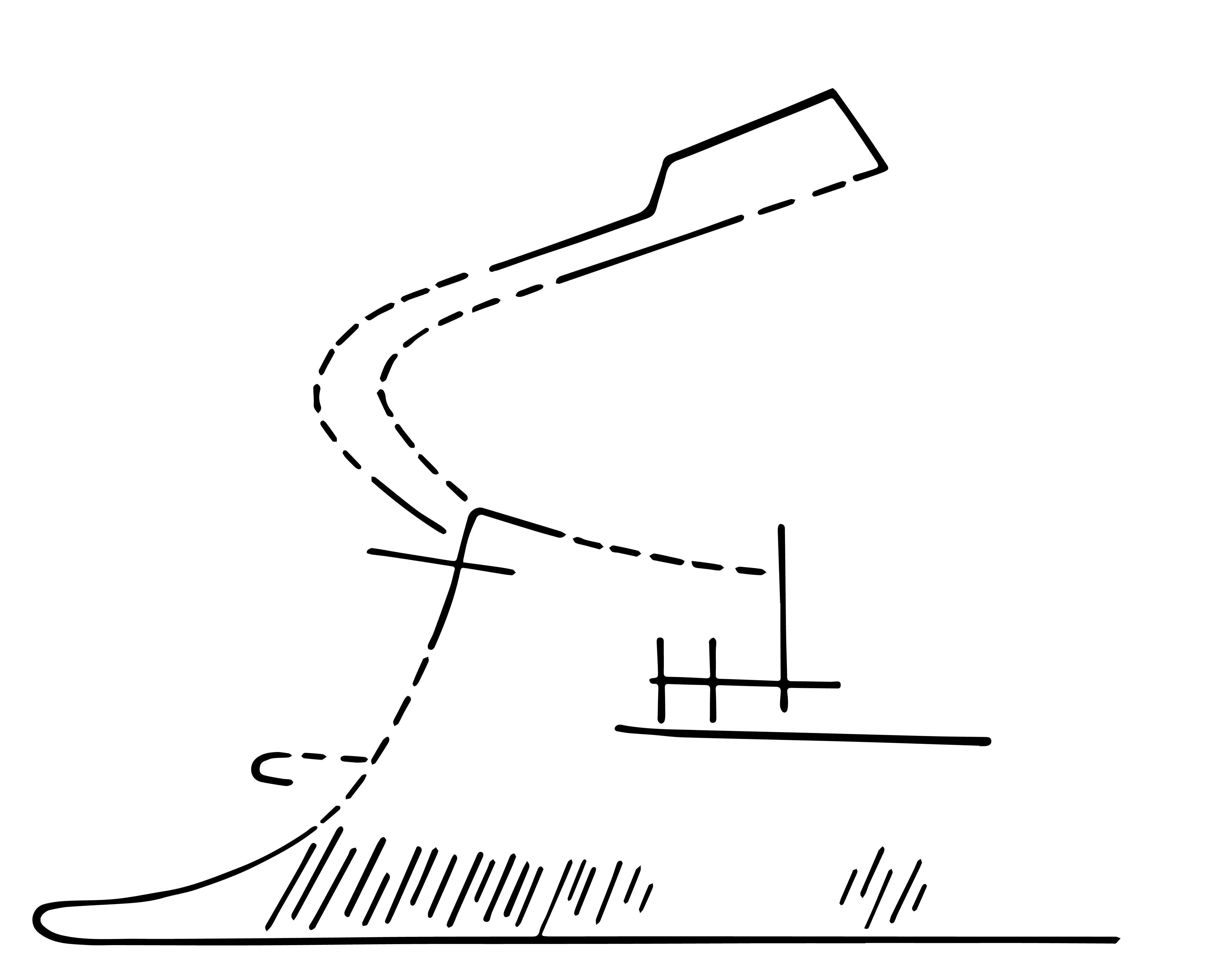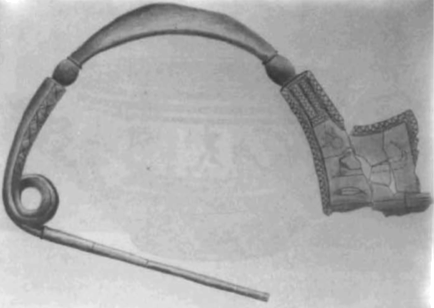Ship to the left of which only the bow is preserved, the rest is corroded. Parts of the bow itself are likewise corroded, but its overall design is clearly defined. The hull is completely flat. The bow is massive and rectangular, with a concave stempost that inclines slightly aft. The stempost ends in a horn device that curves forward then backward, from which point it runs straight and ends in a wider rectangular/paddle shaped extremity. The bow projection is integrated and tapers into a pointed tip. A single plank, most probably a proembolion projects from the stempost near its base, at the juncture with the bow projection. The forecastle is partially damaged by corrosion. It consists of an open balustrade with a latticed railing of which portions of two horizontal and two vertical lines remain. The hull is chased with fine, tightly spaced diagonal lines. Below the ship swims a large fish to the left.
Single-levelled galley
A55
850 B.C. (transitional EG II- MG I period)
Kerameikos Grave 41, Athens
Bronze fibula with a rectangular catch-plate with incised decoration
Basch 1987: 191, no. 402; Coldstream 2003: 35, 37, fig. 14 (context); Kübler 1954: 175, 195, 236, pl. 160f; Mark 2005: 110-11, fig. 49; Tzahou-Alexandri 1990: 353, fig. 3; Van Doorninck 1982: 283, fig. 7
In 10th and 9th century B.C. Athens, adult male and female graves display a clear and distinctive symbolic package which is atypical for the broader Aegean region. Male cremations were generally interred in neck-handled amphorae and are were given warrior equipment such as swords and spears, while female cremations were given belly-handled amphorae and were accompanied by an array of distinctive ornaments, most notably iron dress pins and bronze fibulae. In the 9th century in particular, one unifying feature of distinguished males and females alike is the display of long-distance contacts taking the form of exotic materials, Near Eastern imports, or artifacts displaying imported skills. What is unique to Athens however is that female burials of this period are consistently richer than their male counterparts.
Grave 41 is a securely dated female cremation which belongs to a cluster with two other male cremation graves (42, 43) that were found close to each other at the east end of the Kerameikos cemetery, on the south bank of the Eridanos. Together, these three graves are considered by Whitley as the best-known examples of the male/female categories (Whitley 1996: 221). Coldstream notes that their immediate neighbours are likewise two rich warrior graves of the preceding generation, as well as a third well-furnished grave of a woman dating to c. 900 B.C. (PG gr. 48). This area of the cemetery was therefore clearly reserved for occupants of very high status, although there is no way of telling whether they shared familial bonds. The belly-handled amphora of the woman in grave 41contained three gold finger-rings, a pair of iron pins with wooden globes, gold heads and sheathing, ten bronze fibulae arranged in two chains of five, and a fragmentary ivory object (possibly another seal). This grave has the earliest examples of both types of fibulae that later typically carry incised decoration of ships, namely the square catch-plate and the flat half-moon bow. Not only does it provide the earliest ship representation in this medium, it also considerably predates the earliest ship representations on Geometric vases.
This representation is important for numerous reasons. It is not only the earliest of an important series of fibulae bearing ship representations, but it is also the only one to have a secure and detailed context. It also happens to be the earliest ship depiction from Attica in any medium. Casson and Doorninck argue that it is the earliest representation of a ship fitted with a ram.
Basch, L. 1987. Le musée imaginaire de la marine antique. Athens: Institut Hellénique pour la preservation de la tradition nautique.
Coldstream, J.N. 2003. Geometric Greece: 900-700 B.C. 2nd ed. London: Routledge.
Kübler, K. 1954. Die Nekropole des 10. bis 8. Jahrhunderts. Kerameikos, 5.1. Berlin: Walter de Gruyter.
Mark, S. 2005. Homeric Seafaring. College Station, TX: Texas A&M University Press.
Tzahou-Alexandri, O. 1990. “Contribution to the knowledge of 8th century B.C. Ship Representations,” in H.E. Tzalas (ed.) Tropis II: 2nd International Symposium on Ship Construction in Antiquity. Delphi 1987 (Hellenic Institute for the Preservation of Nautical Tradition). Athens: Hellenic Institute for the Preservation of Nautical Tradition, pp. 333-61.
Van Doorninck, F. H. 1982. “Protogeometric Longships and the Introduction of the Ram,” IJNA 11.4: 277–286.







